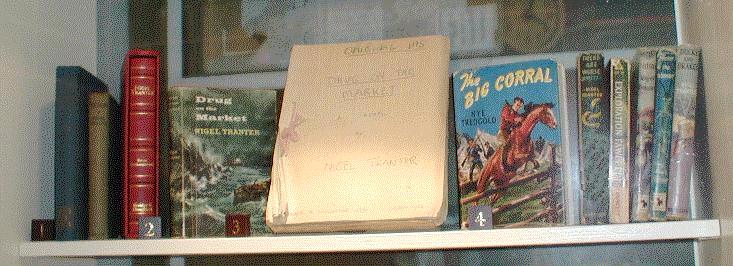

![]()
![]()
![]()
 Next to the typewriter is an unusual paperback of the 'The Courtesan' which is the second of the Master of Gray Trilogy. Unusual because this is a Spanish publication. The three books of the 'The Master of Gray Trilogy' are the only books of Nigel's to be translated into Spanish.
Next to the typewriter is an unusual paperback of the 'The Courtesan' which is the second of the Master of Gray Trilogy. Unusual because this is a Spanish publication. The three books of the 'The Master of Gray Trilogy' are the only books of Nigel's to be translated into Spanish.
Prominent too is the manuscript of 'Lord in Waiting' published in December 1994 by Hodder and Stoughton. Noteworthy is the inevitable bootlace holding the typescript together. The covers were usually recycled card from a Xerox paper box or the like.
Nestling in the corner lies a pile of old laces, picked up while beachcombing as he walked the shores of Aberlady Bay.
On the middle shelf is one of the many Ordnance Survey maps that Nigel owned. This one covers his home territory around his beloved Quarry House which is situated just outside Aberlady and was his home from 1951 to 1998. There too are his pen, paper and notes for that days writing.
From left to right we first of all see a copy of his first book 'The Fortalices and Early Mansions of Southern Scotland' published by the Moray Press in 1935.
This is followed by a copy of 'Trespass' his first novel published by Moray Press in 1937. After only a short print run, the company went into liquidation and the title was subsequently published in 1940 by Ward Lock and Co.
 Next can be seen a beautifully leather bound volume, in a similar slip case. This is a special 'one off' volume of 'Envoy Extraordinary' published in December 1999. It was given to Nigel by his publishers, Hodder and Stoughton, on the occasion of his ninetieth birthday --- November 23rd 1999. In publishing circles this type of volume is called a 'unique edition'
Next can be seen a beautifully leather bound volume, in a similar slip case. This is a special 'one off' volume of 'Envoy Extraordinary' published in December 1999. It was given to Nigel by his publishers, Hodder and Stoughton, on the occasion of his ninetieth birthday --- November 23rd 1999. In publishing circles this type of volume is called a 'unique edition'
Then comes a copy of both the manuscript and the hardback of 'Drug on the Market'. The typescript that would be sent to Hodder and Stoughton is bound in the usual Tranter fashion making use of recycled covers and the inevitable shoelace.
'The Big Corral', one of the ten Westerns written by Nigel under the pseudonym of Nye Tredgold, is next on the shelf. These westerns were written between 1951 and 1958 as 'pot-boilers' to earn some extra cash to put Philip and Frances May through college. Nigel received about £100 for each and wrote one in about six weeks. He researched by reading other westerns from the library. Real Scottish enterprise here. This copy is particularly unique as it bears the signature 'Nye Tredgold' and not the usual 'Nigel Tranter'. With Tredgolds fetching hundreds of pounds this one must top the list for all time. I doubt if another like it exists.
'There are Worse Jungles' based in the forests of Amazonia, appears next on the shelf and, once again, we see that, from the slimmest of research, Nigel could weave a fascinating story. His research for that book plus 'Rio D'Oro' and 'The Long Coffin' was inspired by the adventures of Colonel P.H.Fawcett. Indeed the book that influenced Nigel, entitled 'Exploration Fawcett' by Fawcett's son Brian Fawcett. is next on our shelf.
Next we find 'Border Riding'(1959) and 'Nestor the Monster' (1960) Two of his childrens books, published by Brockhampton, again show his diversity of interest at this time. In all he wrote twelve childrens books between 1958 and 1968.
Lastly comes 'Ducks and Drakes' published in 1953 in the genre of a light-hearted story based on duck shooting. A topic close to the younger Nigel's heart as, a keen wild fowler, he knew the marshes of Aberlady Bay like the proverbial 'back of his hand'.
With the publication of 'The Master of Gray' trilogy Nigel left all the above styles of writing behind and embarked on the genre that was to see him achieve world-wide appeal. The historical novel.